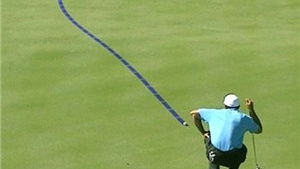AimPoint: Putting experience reviewed
How I joined a session to learn a unique green-reading technique

Keen to improve my putting and following a recommendation by respected Essex club-fitter Lee Porter, I recently attended an AimPoint putting clinic for eight club golfers at Wrotham Heath in Kent under the expert tuition of Europe's senior AimPoint instructor, Jamie Donaldson (Cambridge Golf Centre, Hemingford Abbots) and James Skelton (Wrotham), currently undergoing AimPoint instructor qualification.
If like most of us golfers, however, you don't have this technology then try our aimpoint practice putting drill that uses our own built in tracking system to read greens.
As Golfmagic visitors may already have seen on Golf Channel coverage of the PGA Tour, AimPoint is green-reading technology, where lines are superimposed on the screen showing the path the ball will take to toward the hole, based on precise mathematical modelling of the effect of gravity on the golf ball as it rolls across a slope.
AimPoint says the revolutionary system takes out the guesswork in determining how much break there is in a putt and identifies precisely how much a golfer needs to aim their putt for the ball to go in the hole.
None of this…"just outside left edge" malarkey. The technology advises for example "four inches right".
Here's my review of the Aim Point session I experienced.
How the sessions work
The session at Wrotham started with practical demonstrations for accurately identify slopes on greens - not necessarily ones you can see. Often, your eyes can be easily deceived by green shapes and outside information leading you to believe a slope exists when it does not.
Time was spent learning how slopes affect the path of a ball and how a slope can affect the ball in different ways, depending upon the length of the putt.
Fundamental for every hole position on the green, there will be a ball position where, at a given length, the putt is perfectly straight. There will be somewhere at 5ft where you have a straight putt, at 10ft and at 15ft. These positions may not necessarily all be in a straight line but they do exist.
Depending on green shape, we were told, there may be a number of positions around the hole where a straight putt exists both above and below the hole. Identify these 'zero lines' is the basis of the system.
Factors affecting each putt
The session also demonstrated how much the difference in angle of a putt compared to the 'zero line' affected the break. Unsurprisingly, putts made at 90 degrees to the 'zero line' are affected far more severely than those made at a shallower angle. The Aimpoint system uses mathematical modelling used on TV to predict the break of a putt is, depending on a number of factors.
These include:
· Putt length
· Angle of putt relative to the 'zero line' (in 15-degree increments)
· Uphill or downhill
· Speed of the green (stimp rating)
· Slope (gradient) of the green down the 'zero line'
With these factors known the golfer looks up on an AimPoint chart and reads off the appropriate amount of break. He or she then aims the putt. It's that simple.
Knowing the stimp or slope of a putt
So how how do you know these numbers? I found the Aimpoint clinic furnished me with techniques and understanding of how to determine this information. They are subjective but once I started using the system I could adjust my determination of stimp or
Click on the next page to have a further look at the AimPoint technology...
��

